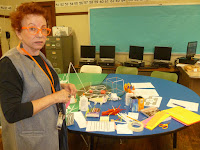Above: Amulet of Isis and Horus North Carolina Museum of Art 305-30 B.C.E.
Above: Amulet created by New Roberto Clemente School 6th grade student 2017
New
Roberto Clemente School 6th grade students have continued to learn about the art
of Ancient Egypt. They teleconferenced live with the North Carolina
Museum of Art on February 29, 2017 and December 7, 2016 in what was "Phase Three" of
this on-going collaborative project, "Gaining STEAM from Ancient Egyptian Artifacts." During Phase Three, Ms. Camille Tewell, Art Educator for the Museum, asked the students, "Why do humans make?", a question that elicited many thoughtful responses.
Students thought about human making in the past and reflected upon human making today in our contemporary culture. Following this discussion the students received the form below. Ms. Tewell asked students what type of amulets they could create for themselves. In addition they were asked what special powers these amulets could have and what materials they might be made of.
NRC students worked with their art and technology teachers to answer these questions. Students freely borrowed artistic ideas from Ancient Egyptian hieroglyphs and other iconography to create these designs. They brainstormed materials for their amulets.
Using Inkspace and later Tinkercad (free applications on the computer) students transferred their amulet designs from the piece of white paper to a digital file that the Makerbot 3D printer in their classroom could use. The Makerbot received the file and printed out the amulet using filament with a color chosen by each student. Next, Mr. Baldwin and his students printed out these disk shaped amulets, one for each student.
Above and right : NRC Technology Teacher Mr. Baldwin teaches students about the 3D printer. Students are very eager to learn about this intriguing machine!
 Next, a few sixth grade students also ventured into more sophisticated 3D designing with Tinkercad and produced 3D 'sitting' amulets with impressive designs and features.
In order to do this, the designs needed to be tweeked and re-tweeked in the 3D printing process. Mr. Baldwin compared this editing process to solving a problem in mathematics. Students learned both the potential and the limitations of the 3D printer in this project.
Below: an elaborate amulet necklace designed by one of Mr. Baldwin's students. This student made a first print in blue filament but realized she had made the design too thin when the blue copy broke. Thus she edited her design to make the necklace both thicker, and attached to a black base. The new necklace is printed in orange and in a stronger type of filament.
Next, a few sixth grade students also ventured into more sophisticated 3D designing with Tinkercad and produced 3D 'sitting' amulets with impressive designs and features.
In order to do this, the designs needed to be tweeked and re-tweeked in the 3D printing process. Mr. Baldwin compared this editing process to solving a problem in mathematics. Students learned both the potential and the limitations of the 3D printer in this project.
Below: an elaborate amulet necklace designed by one of Mr. Baldwin's students. This student made a first print in blue filament but realized she had made the design too thin when the blue copy broke. Thus she edited her design to make the necklace both thicker, and attached to a black base. The new necklace is printed in orange and in a stronger type of filament.
Below: A seated purple amulet gets tweeked on the computer and initial design flaws are corrected before re-printing.
 Students have become very fascinated with both Ancient Egyptian Art and 3D printing at NRC as a result of this project. STEAM Art PIR Triada Samaras presented this project in December to PIRS in other WP Professional Development Schools. This
was a true STEAM activity that crossed several disciplines. Technology teachers (Mr. Baldwin and Ms. Selino), art teachers (Ms. Mandal and Ms. Senopole), and social studies teacher (Mr. Fusco), and Art Professor Triada Samaras all contributed with the staff from the Education Department at NC Museum of Art to make this project a giant success at NRC.
Students have become very fascinated with both Ancient Egyptian Art and 3D printing at NRC as a result of this project. STEAM Art PIR Triada Samaras presented this project in December to PIRS in other WP Professional Development Schools. This
was a true STEAM activity that crossed several disciplines. Technology teachers (Mr. Baldwin and Ms. Selino), art teachers (Ms. Mandal and Ms. Senopole), and social studies teacher (Mr. Fusco), and Art Professor Triada Samaras all contributed with the staff from the Education Department at NC Museum of Art to make this project a giant success at NRC.
For More Information on This Project Please See:
Phase Two: Egyptian Amulet STEAM Collaboration with the North Carolina Museum of Art!
Phase One: A "Virtual" Museum visit from the North Carolina Museum of Art!
 The month of February was an especially interesting one for the teachers from School 2 and School 12 who attended workshops given by Art PIR Simone Sandler. At left, Ms. Sandler stands before the materials she prepared for the workshop.
The month of February was an especially interesting one for the teachers from School 2 and School 12 who attended workshops given by Art PIR Simone Sandler. At left, Ms. Sandler stands before the materials she prepared for the workshop.


































































